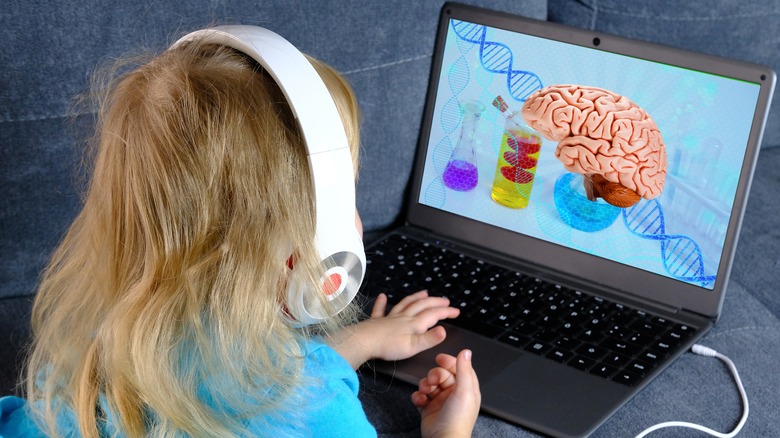Childhood is sometimes thought of as a simpler time that we would love to go back to as adults — we believed in Santa, played hide and seek, had no bills to pay, and perceived the world around us with awe and wonder. For many people though, childhood was a painful time when they were exposed to the harsh realities of the world too soon. This is also common, as over two-thirds of children have experienced some form of trauma by the age of 16, according to the Substance Abuse and Mental Health Services Administration.
There are a number of events that can be considered traumatic for a child. Some include experiencing the death of a loved one, physical, emotional, or sexual abuse, domestic violence in the household, neglect, or having a life-threatening condition. As described in a 2024 study published in PLOS One, living in a household with a caregiver who is struggling with addiction can also be traumatic. In addition, research shared by California Healthline suggests that children living in impoverished or dangerous neighborhoods can be more likely to experience traumatic events.
As adults, it would be easier to leave these memories behind, but sometimes, they follow us into adulthood. Childhood trauma can have a significant impact on someone’s quality of life as an adult, but there are also many ways that one can begin to heal from a traumatic past. It may be helpful to start by investigating how trauma can impact a child.
It can change brain chemistry

It has been proposed that trauma during childhood may impact brain development on a biological level. Childhood and adolescence are critical periods for neuroplasticity, as the brain is in its most sensitive developmental stages. As further described in BrainLine, the term “neuroplasticity” refers to the process in which the brain develops and adapts based on external experiences in its environment.
According to the Children’s Bureau, brain imaging studies have detected abnormalities in the brains of some children who experienced abuse, neglect, or other forms of maltreatment. Researchers recognize the possibility of outside variables influencing the results, yet believe the correlation between childhood maltreatment and changes in the brain appears to be significant. A few differences the Bureau noted were a smaller hippocampus and an increase in the reactivity of the amygdala in some individuals who reported being exposed to trauma in their youth. The hippocampus is a structure of the brain connected to the cognitive functions of learning and memory, and the amygdala helps us process emotions.
Scientists are also investigating whether childhood trauma can alter an individual’s gene expression. In a 2024 review published in Neuron, researchers discussed the relationship between childhood trauma and the shortening of telomeres. As illustrated by the National Human Genome Research Institute, deoxyribonucleic acid (DNA) is located in the nucleus of a cell and carries genetic information. Telomeres are repeating segments of DNA that protect the ends of chromosomes from damage, and they become shorter whenever a cell divides.
It can contribute to mental health disorders
Along with potentially modifying brain chemistry, childhood trauma can increase the risk of developing a mental health disorder by adulthood. According to an article published in Stanford Medicine, it is reported that children exposed to trauma are 30 times more likely to develop learning and behavioral difficulties. Additionally, the Office on Women’s Health states that experiencing trauma and abuse can have adverse effects on mental health, such as triggering suicidal thoughts and behaviors, eating disorders, and self-harm. Those exposed to trauma or abuse have a higher likelihood of developing psychological disorders like depression, anxiety disorders, addiction, borderline personality disorder (BPD), and post-traumatic stress disorder (PTSD). There is another form of PTSD known as Complex PTSD, which can develop after living through multiple traumatic events over an extended period of time (per National Health Service).
Borderline Personality Disorder, in particular, is a mental condition that affects the way an individual perceives themselves and how they interact with others. The symptoms of this disorder can lead to interpersonal conflict despite wanting to become closer to others, impulsive and self-sabotaging behavior that can push others away, and intense fears of abandonment or rejection (per Mayo Clinic). Childhood trauma appears to be a major contributor to the development of BPD, along with genetic predispositions. As reported by the clinic, many people with BPD have described being abused, neglected, losing a parent, or having caregivers who struggled with addiction as children.
It can affect adult relationships
Inside Creative House/Shutterstock
The very first relationships we have with our caregivers in childhood set the stage for how we perceive intimate relationships in adulthood. A child needs to know they are safe, protected, and cared for by those around them. Unfortunately, many children do not receive this emotional validation from their caretakers, which can affect their attachments to new people. The Children’s Bureau reports that the brains of children exposed to threatening environments are likely to shift into “survival mode,” making the world around them feel like a dangerous place.
John Bowlby, a British psychologist, examined attachment styles and how separation from caregivers affects children. Those who form healthy bonds with their caretakers are more likely to develop a secure attachment style, feeling reassured that their loved ones will not abandon them. In comparison, those with unhealthy bonds to their caretakers may display insecure attachment styles (per Verywell Mind). For example, an avoidant attachment style can develop after being abused or neglected by caregivers and may contribute to avoidant behavior or refusing to seek help from others.
Establishing trust is essential for sustaining a healthy, long-lasting relationship with others. Sadly, being exposed to childhood trauma may affect an individual’s ability to trust. In a 2024 study published in Borderline Personality Disorder and Emotion Dysregulation, researchers implemented a distrust game with the participants. They discovered the participants who had experienced more childhood maltreatment showed greater distrust and were less consistent when judging photographs of unfamiliar faces.
It can be passed down from generation to generation
Fizkes/Shutterstock
It is possible that a cycle of trauma that remains unaddressed can pass down the family line and on to the next generation. As described by the American Psychological Association, a doctoral psychology student named Brent Benzo conducted an experiment on three generations of Ukrainian families after the Holodomor genocide. Many participants reported living in “survival mode” after the trauma and noticed maladaptive behaviors within their families, such as authoritarian parenting styles and a lack of trust in their community. Benzo believed that the younger generations learned from the behaviors of the previous generations, and they learned not to trust the world around them.
Some noticeable behavioral patterns that may be passed down include strict or emotionally uninvolved parenting styles, denial of the trauma, the use of substances to numb painful emotions, dissociation and detachment from your feelings, or suicidal thoughts and behaviors (per Healthline). In an interview with Healthline, trauma therapist Cahn Tran shared how it could be challenging for a person to recognize that they have been traumatized because the behaviors can become normalized within the family.
By acknowledging the pain of trauma and taking steps to heal, we may be more able to prevent passing the hurt on to future generations. Tran suggests working with a trauma-informed therapist, in particular, because they can help you understand the impact that intergenerational trauma might have had on family dynamics.
Healing from childhood trauma
Studio Romantic/Shutterstock
Experiencing buried feelings from childhood can be intimidating, but it could help to remind ourselves that we don’t have to tackle them on our own. Despite what happened in the past, we can look forward to a bright future. One way that a trained professional can help someone heal from the events of childhood is through inner child work. The “inner child” is a concept that was popularized by the psychologist Carl Jung, and represents an individual’s childlike aspect that lives on, even in adulthood (per CPTSD Foundation). Inner child work is an approach to connecting with the inner child inside us and helping them heal from what they went through. According to the foundation, adults who experienced trauma as a child may struggle with internalized shame and repress their emotions because they are too painful.
Connecting with the inner child by acknowledging their existence and their emotions, writing letters to them, doing inner child meditations, and learning how to re-parent oneself with self-loving affirmations may be therapeutic for some individuals who have experienced childhood trauma. Because of the uncomfortable memories and feelings that may resurface during the process, the foundation suggests working through them with a trusted individual, such as a therapist.
If you or someone you know is struggling with mental health, please contact the Crisis Text Line by texting HOME to 741741, call the National Alliance on Mental Illness helpline at 1-800-950-NAMI (6264), or visit the National Institute of Mental Health website.


